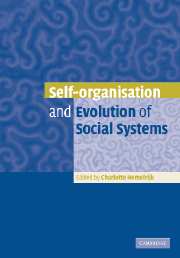Book contents
- Frontmatter
- Contents
- List of contributors
- Preface
- Introduction
- 1 From unicellular to multicellular organisation in the social amoeba Dictyostelium discoideum
- 2 Optimality of communication in self-organised social behaviour
- 3 The interplay of intracolonial genotypic variance and self-organisation of dominance hierarchies in honeybees
- 4 Traffic rules of fish schools: a review of agent-based approaches
- 5 A process-oriented approach to the social behaviour of primates
- 6 Order and noise in primate societies
- 7 Self-organisation in language
- 8 Dictatorship effect of majority rule in voting in hierarchical systems
- 9 Natural selection and complex systems: a complex interaction
- 10 Interlocking of self-organisation and evolution
- Index
- References
Preface
Published online by Cambridge University Press: 07 December 2009
- Frontmatter
- Contents
- List of contributors
- Preface
- Introduction
- 1 From unicellular to multicellular organisation in the social amoeba Dictyostelium discoideum
- 2 Optimality of communication in self-organised social behaviour
- 3 The interplay of intracolonial genotypic variance and self-organisation of dominance hierarchies in honeybees
- 4 Traffic rules of fish schools: a review of agent-based approaches
- 5 A process-oriented approach to the social behaviour of primates
- 6 Order and noise in primate societies
- 7 Self-organisation in language
- 8 Dictatorship effect of majority rule in voting in hierarchical systems
- 9 Natural selection and complex systems: a complex interaction
- 10 Interlocking of self-organisation and evolution
- Index
- References
Summary
The study of social systems from the perspective of complexity science leads to unusual results that show that, by self-organisation, complex patterns of behaviour may arise from very simple behavioural rules (Schelling, 1978; Camazine et al., 2001). By building these rules into certain computer models we develop a new type of understanding (Braitenberg, 1984; Pfeifer and Scheier, 1999).
This method may be applied to social systems of all kinds and of all organisms. Yet, so far, it has rarely been used among biologists. Moreover, biologists are little aware of the use of this method in the study of social systems in humans.
Therefore, we feel that there is need for a book on social systems of animals and humans from the perspective of complexity science. In order to interest also empirical scientists in this approach, the book contains both empirical papers and theoretical ones.
To realise all this a conference was essential: we organised a five-day conference in the beautiful surroundings of Monte Verità in Switzerland. The authors of the papers of this book were invited speakers at this conference. I wish to thank them for the timely submission of their papers and for their cooperative attitude during refereeing. I am grateful to Paulien Hogeweg, and Bernard Thierry for their useful general comments and to Jens Krause and Hanspeter Kunz for refereeing and to Dan Reid for his work on the index. I am grateful to the Centro Stefano Franscini of the Eidgenössische Technische Hochschule Zürich and the University of Zürich for their liberal financial support.
- Type
- Chapter
- Information
- Publisher: Cambridge University PressPrint publication year: 2005
References
- 1
- Cited by

